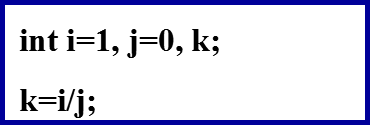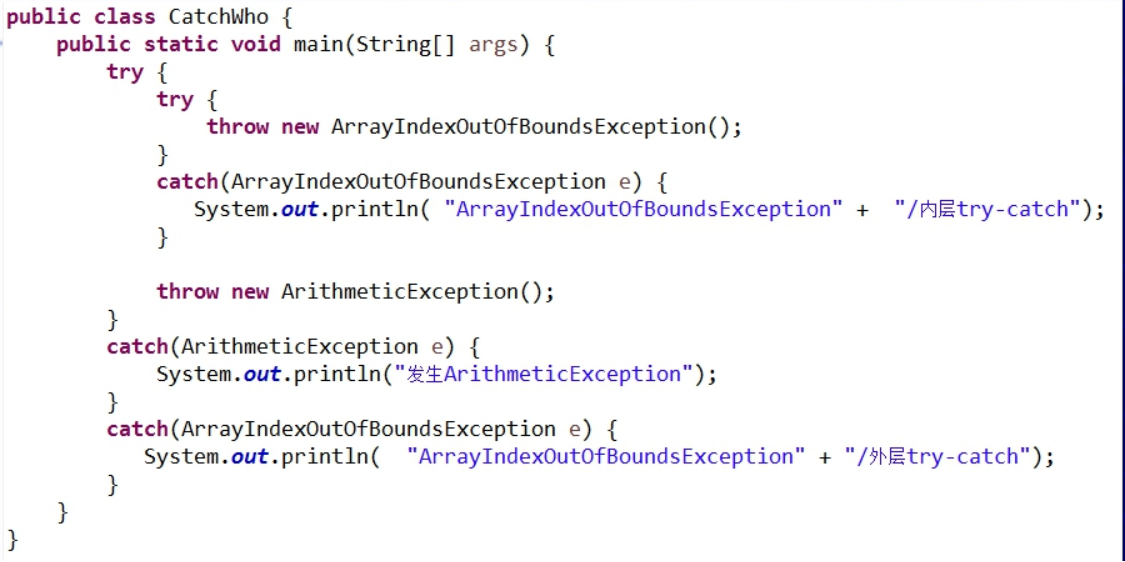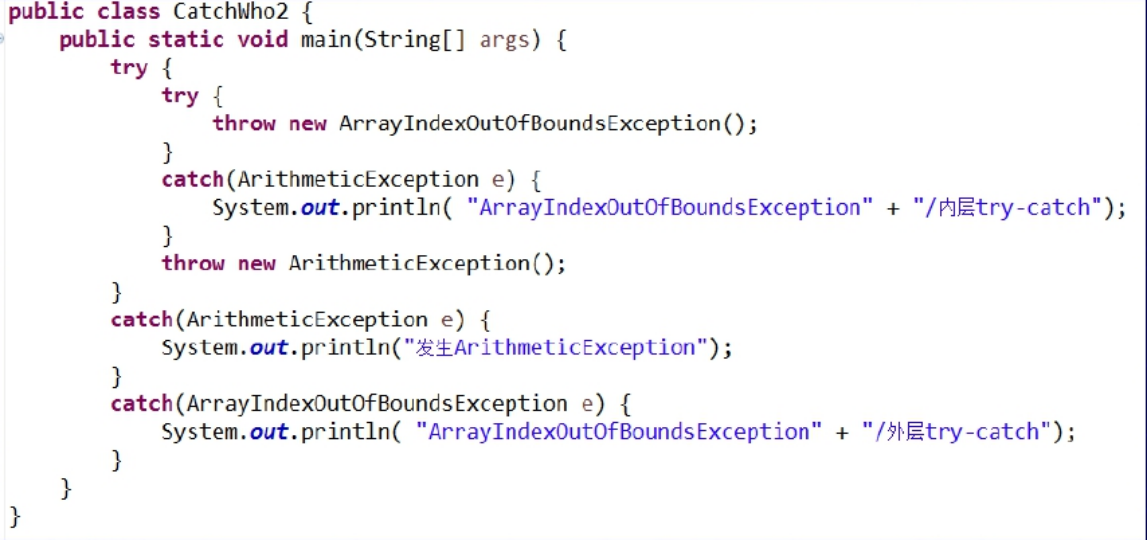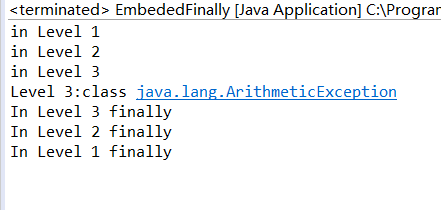1.请阅读并运行AboutException.java示例,然后通过后面的几页PPT了解Java中实现异常处理的基础知识。
AboutException.java代码如下
import javax.swing.*; class AboutException { public static void main(String[] a) { int i=1, j=0, k; //k=i/j; try { k = i/j; // Causes division-by-zero exception //throw new Exception("Hello.Exception!"); } catch ( ArithmeticException e) { System.out.println("被0除. "+ e.getMessage()); } catch (Exception e) { if (e instanceof ArithmeticException) System.out.println("被0除"); else { System.out.println(e.getMessage()); } } finally { JOptionPane.showConfirmDialog(null,"OK"); } } }
(1)运行结果截图

(2)基础知识
把可能会发生错误的代码放进try语句块中。
当程序检测到出现了一个错误时会抛出一个异常对象。异常处理代码会捕获并处理这个错误。 catch语句块中的代码用于处理错误。
当异常发生时,程序控制流程由try语句块跳转到catch语句块。 不管是否有异常发生,finally语句块中的语句始终保证被执行。
如果没有提供合适的异常处理代码,JVM将会结束掉整个应用程序。
2.
请尝试解释以下奇怪的现象!






上边代码在运行时 不会引发异常
解释:第一个程序进行反编译后生成idiv字节码指令
第二个程序进行反编译后生成ddiv字节码指令
JVM在具体实现这两个指 令时,采用了不同的处理 策略,导致两段代码运行 时得到不同的结果
3.阅读以下代码(CatchWho.java),写出程序运行结果

结果
4.
写出CatchWho2.java程序运行的结果

结果:
5.
请先阅读 EmbedFinally.java示例,再运行它,观察其输出并进行总结。
public class EmbededFinally { public static void main(String args[]) { int result; try { System.out.println("in Level 1"); try { System.out.println("in Level 2"); // result=100/0; //Level 2 try { System.out.println("in Level 3"); result=100/0; //Level 3 } catch (Exception e) { System.out.println("Level 3:" + e.getClass().toString()); } finally { System.out.println("In Level 3 finally"); } // result=100/0; //Level 2 } catch (Exception e) { System.out.println("Level 2:" + e.getClass().toString()); } finally { System.out.println("In Level 2 finally"); } // result = 100 / 0; //level 1 } catch (Exception e) { System.out.println("Level 1:" + e.getClass().toString()); } finally { System.out.println("In Level 1 finally"); } } }
(1)运行结果

(2)总结
try...catch语句为配对出现,程序会按着代码的顺序依次执行,当try中语句出现异常时,他会执行与当前try配对的catch语句。
6.
辨析:finally语句块一定会执行吗?
请通过 SystemExitAndFinally.java示例程序回答上述问题
public class SystemExitAndFinally { public static void main(String[] args) { try{ System.out.println("in main"); throw new Exception("Exception is thrown in main"); //System.exit(0); } catch(Exception e) { System.out.println(e.getMessage()); System.exit(0); } finally { System.out.println("in finally"); } } }
finally不会每次都执行,例如以上程序,当执行完throw new Exception("Exception is thrown in main");语句后便关闭了程序。
7.如何跟踪异常的传播路径?
当程序中出现异常时,JVM会依据方法调用顺序依次查找有关的错误处理程序。
可使用printStackTrace 和 getMessage方法了解异常发生的情况: printStackTrace:打印方法调用堆栈。
每个Throwable类的对象都有一个getMessage方法,它返回一个字串,这个字串是在Exception构造函数中传入的,通常让这一字串包含特定异常的相关信息。
8.
请看以下代码,它们完全符合Java语法规范,但事实是它们不能通过编译: public class TestThrows { public static void main(String[] args) { FileInputStream fis = new FileInputStream("a.txt"); } }
解释:
throws语句表明某方法中可能出现某种(或多种)异常,但它自己不能处理这些异常,而需要由调用者来处理。 当一个方法包含throws子句时,需要在调用此方法的代码中使用try/catch/finally进行捕获,或者是重新对其进行声明,否则编译时报错。
9.
编写一个程序,此程序在运行时要求用户输入一个 整数,代表某门课的考试成绩,程序接着给出“不及格”、“及格”、“中”、“良”、“优”的结论。 要求程序必须具备足够的健壮性,不管用户输入什 么样的内容,都不会崩溃。
//信1605-3 20163677 多文佳 import java.util.*; public class test { public static void main(String[] args) { try { System.out.println("请输入一个成绩"); Scanner sc=new Scanner(System.in); double a=sc.nextDouble(); if(a<60&&a>=0) System.out.println("不及格"); else if(a<70) System.out.println("及格"); else if(a<80) System.out.println("中"); else if(a<90) System.out.println("良"); else if(a>=90&&a<=100) System.out.println("优"); else System.out.println("您输入的成绩无效"); } catch(Exception e) { System.out.println("您输入的成绩无效"); } } }